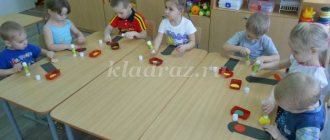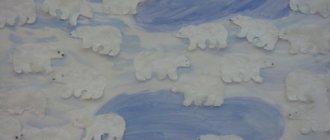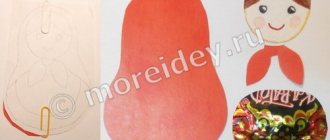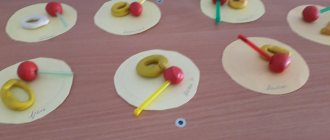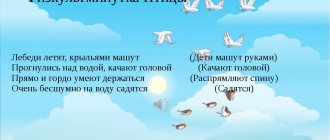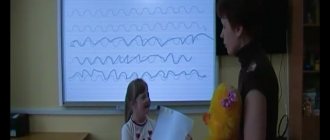DIY flat traffic lights
Such traffic lights can be made in the form of an application that is hung on the wall. Or stick colored circles on cardboard or a box that is placed on the podium.
Younger children need help drawing the circles for the traffic lights and cutting them out evenly. School-age children can do this on their own.
Made from cardboard and colored paper
- Cut out a strip from dark cardboard.
- We glue it between two black rectangular cardboard blanks.
- On both sides of the rectangles we glue three circles of red, yellow and green.
The visual teaching aid is ready and can be taken to kindergarten or school.
From disks
In every home there are three disks that are not used for their intended purpose because they are scratched or have lost their relevance. They can be used to create a traffic light. Moreover, the shape of the disk is round and there is no need to cut such a shape from other materials.
Progress:
- Place a disk on colored paper and trace its outline.
- Cut out colorful circles.
- Stick them on disks.
- On each disc with a certain color you can draw a funny face. For example, on a red disc it will be sad because movement is prohibited. And on the yellow disk, the face takes on a serious expression, which means to prepare for the transition. On the green disk the image is smiling because movement can be made.
- The finished discs are glued in the correct order onto cardboard, plastic and wooden surfaces. You can create the most unusual designs, but the order of colors in a traffic light remains unchanged.
- You don’t have to completely cover the disk, but glue multi-colored bottle caps to the middle to create a traffic light. Or you can stick strips on the disk in the form of sun rays of different colors.
There are many options for making crafts from disks, and the main thing is to show your imagination. If you make pompoms from yarn, then they are glued on a disk instead of a nose in the middle, and eyes and a mouth are glued from paper. The result will be multi-colored clowns, each with its own facial expression corresponding to the color of the traffic light.
From colored bags
To create a traffic light from packages, you need to stock up on packages of the colors present in the traffic light.
Progress:
- Cut off the handles and bottom.
- Lay out the bag in the form of a rectangle.
- Bend it in half.
- Cut into centimeter strips up to the fold line.
- Connect the resulting parts with tape to form a ball.
- The balls can be attached in a hollow box or connected together like a snowman.
- Decorate with a cap cut out of cardboard and glue on the hands. Place the wand in one hand.
This traffic light is pleasant to the touch and looks very interesting.
Paper applique
Everyone has such a material as paper in their home. Therefore, making our Traffic Light will not be difficult.
What we need:
- Sheet of cardboard
- Colored paper
- PVA glue
- Scissors
- Stationery knife
- Scotch
- Gouache
- Brushes
- Sippy cup and water
So, let's get started:
- First we need to take a sheet of cardboard, it should be rectangular in shape.
- Dip the brush into water and then into black paint and decorate our cardboard.
- While the sheet dries, let's work on colored paper. We need certain colors: red, yellow and green. It is these flowers that our craft consists of.
- Take scissors and cut out circles. To make them even, you can use a compass or use improvised objects.
- This could be a glass or mug.
- You can add originality to our traffic lights and cut them into different shapes, so that you can then glue them onto our signal circles.
- They can be in the shape of hearts or small flats with which you can decorate everything.
- You can use glitter or eggshells this way. It all depends on your imagination and the imagination of your child. As shown below in the picture.
- In the meantime, the cardboard has dried and we can connect all our parts.
- You need to make marks on the cardboard so that the circles are glued at the same distance from each other.
- Then we smear the colored circles with glue and carefully glue them each into place.
- There is red at the very top, yellow in the middle, and green at the bottom. We wait. Let it dry. And look what we got.
Floral traffic light made of hearts
This will help you learn the colors and rules of the road and the kids will love it. The applique is also suitable for making in the middle group.
To work you will need:
- black cardboard - it will be used as a stencil;
- sheets of double-sided colored paper;
- glue stick;
- scissors;
- compass, ruler and simple pencil.
Step-by-step instruction:
- First, make heart blanks of different sizes - from yellow, red, green paper.
- Fold the cut pieces in half.
- Use a pencil, ruler and compass to draw three circles of the same diameter on the cardboard.
- Start making a traffic light. Let your child use his imagination and come up with a pattern himself. To lay it out, take glue and spread it on the heart halves. Then they are glued. Make a red signal first - don't forget to explain what it means.
- Make yellow and green signals in the same way.
- To diversify your work and get a craft like in the photo, create a frame from leftover colored paper. To do this, bend it in half and glue a few more hearts.
Craft difficulty level
The complexity of the traffic rules craft should be commensurate with the age of the child.
Pupils of the junior group of preschool institutions perform simple applications from figures that the teacher has cut out in advance. Thus, we can use an example to explain to children what a “zebra crossing” is, what traffic lights have and what they mean, what the main various signs are for motorists and those on foot.
Pupils of the middle group perform crafts of traffic rules for kindergarten with their own hands using more complex techniques. It can also be an applique, but the children already cut out the figures themselves or make the same traffic light, but using the cutting technique.
In this case, the paper of the desired color is torn into small pieces by hand, the free space of the template is filled with glued pieces of colored paper.
Other works for the children's drawing competition “I know the rules of the road”
Publications on the topic:
Scenario for the entertainment “Funny Traffic Light” for children of middle and senior groups Children line up on the street playground to the song “Road Rules”. Educator: - Guys, we live in a big, beautiful city. What is our city called?...
Scenario of the event on traffic rules “Happy Traffic Light” On September 20, an event on the Rules of the Road “Jolly Traffic Light” was held in the kindergarten. The purpose of the event is to consolidate the ability to use the rules of the road...
GCD “Cheerful traffic light” in the second junior group Priority educational area: social and communicative development Developing subject-spatial environment of the GCD theme: Box (parcel) - 1 pc., traffic light,…
Traffic light from a tin
There is always a tall, narrow, round-shaped tin box in the household. It can easily be turned into a traffic light. Stages of work:
- We cut out circles from cardboard, cover them on one side with double-sided tape and cut them along the contour along with the tape.
- We cover the tin with black corrugated paper and glue blank circles to this base, three on each side, so that the tape remains on the outside.
- We remove the tape from each circle one by one and sprinkle it with sparkles of the corresponding color, distributing them evenly so that there are no gaps.
- We cut out six semicircles from black velvet and glue them above each circle to make visors.
- Cover the top of the traffic light with a black circle.
This model is good because it does not need a stand, since the tin will remain on the table without it.

